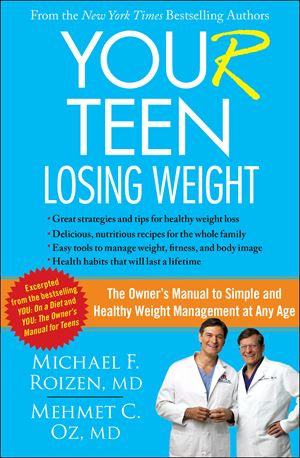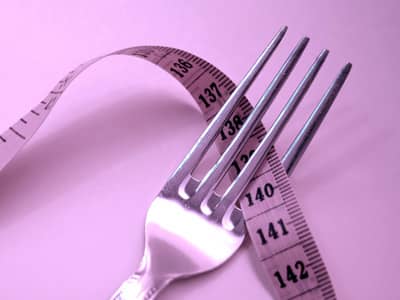
Excerpted from YOU(R) Teen: Losing Weight: The Owner’s Manual to Simple and Healthy Weight Management at Any Age. Introduction copyright © 2012 by Michael F. Roizen, MD, and Oz Works, LLC Excerpted with permission by Scribner, a division of Simon & Schuster, Inc.
How do you know what foods to avoid and strategies to use when you’re face to face with foods that are more evil than an Avengers villain? Here are some tips from YOU(R) Teen Losing Weight that will give you the foundation to help you make healthy living easy (and fun).
Know good versus not good. Generally, ingredients can be classified into these two groups. By knowing which foods fall into which categories, you’ll go a long way toward making lasting changes—and making smart choices at every meal and snack.
Healthful ingredients: lean protein (such as skinless turkey and chicken, fish), healthful fats (such as omega-3 fatty acids, unsaturated fats), healthful carbohydrates (100 percent whole grain), fiber (oatmeal, vegetables, psyllium husks).
Unhealthful ingredients: the five food felons: (1) added simple sugars, (2) enriched (or bleached or refined) flour, (3) added syrups such as HFCS (also called corn sugar), (4) saturated fats (four-legged animal fat, two-legged animal skin, coconut and palm oils), and (5) trans fats.
First, avoid simple sugars and syrups. Saturated fats and trans fats are other ingredients to avoid. Finally, stay clear of enriched, bleached, and refined flour. All three words mean that the flour has been stripped of its nutrients. All of these in excess can contribute to obesity and lead to other long-term health risks. Use flour made 100 percent with whole grains instead.
The ideal is to eat these healthful foods in balance: a little protein, healthful fats, and healthful carbs at each of your meals. Lean proteins include chicken, turkey, fish (great for those omega-3 fatty acids). Healthful fats (you need at least 30 to 50 grams worth a day) include olives, natural peanut butter, olive oil, hummus, and many other Mediterranean-style foods. Healthful carbs that can also give you needed fiber include things cooked with chia seeds and whole grain flour, anything whole grain, whole wheat pasta, brown rice, and don’t forget your fruits and veggies.
Don’t undereat. When our ancestors couldn’t find food and went for long periods of time without it, their bodies acted like life preservers, storing fat in anticipation of the inevitable periods of famine. The same system works today. When you try to “diet” by going for long periods of time without eating or by eating way too few calories, your brain senses the starvation and sends an SOS signal through your body to store fat because famine is on its way. That’s why people who go on extreme fasts and extremely low-calorie diets don’t lose the expected weight. They store fat as a natural protective mechanism. To lose weight, you have to keep your body from switching into starvation mode. The only way to do it: eat often, in the form of frequent healthful meals and snacks.
Ballpark (don’t obsess) the calories. Some people like to count calories; others can’t stand it. So if you are tech-minded, you may like to do the math and track calories. But it’s not necessary, especially since there’s such a wide range of caloric requirements depending on individual needs. Most teens need a minimum of 2,000 calories a day just to keep their bodies functioning. But athletes—and those of us growing (most teens are!)—may need significantly more than that. Those who are actively trying to lose weight shouldn’t go below 1,500 to 1,800 calories a day.
Automate your eating. If any waist management plan is going to work—as in really work—eating right has to become as automatic as it was for our ancestors. That’s not as insurmountable as it seems. Just look at one study from The Journal of the American Medical Association. Two groups were assigned two different diets. One went on a diet rich in good-for-YOU foods such as whole grains, fruits, vegetables, nuts, and olive oil, foods found in the typical Mediterranean diet. The other group was not given any specific direction in terms of foods to eat but was instructed to consume specific percentages of fat, carbohydrates, and protein daily.
In short, they had to think a lot about preparing foods and dividing amounts, while the first group had only general guidelines about foods to eat. The groups weren’t given guidelines about how much to eat; they let their hunger levels dictate their hunger patterns. When they did that, what happened? Without trying, the first group consumed fewer calories, lost inches, and dropped pounds. The point: the people in the “good-for-YOU-foods group” ate the foods that naturally kept them satiated so that their bodies could seek their playing weights.
❑ The “good-for-YOU-foods group” consumed significantly more fiber than the control group.
❑ The “good-for-YOU-foods group” consumed higher amounts of good-for-YOU omega-3 and omega-9 fats in the form of olives, fish, and nuts (especially walnuts). Those fats help increase the level of chemicals that make you feel satiated.
❑ The “good-for-YOU-foods group” more than doubled their consumption of fruits and vegetables.
❑ The “good-for-YOU-foods group” ate the foods we recommend here, didn’t obsess about calories, and enabled their bodies to do what they’re supposed to do: regulate the chemicals that are responsible for hunger and for satiety.
Pick and stick. Yeah, sure, variety may be the spice of life, but it can also be the death of healthful eating. When you have lots of choices for a meal, it’s much easier to slip out of good eating habits and into fried-ham-induced bad ones. One way to avoid excess fat intake is to eliminate choices for at least one meal a day. For teens, that’s most often breakfast. So find two or three healthful breakfasts that you like—say, oatmeal, cereal with low-fat milk, yogurt with fruit, or all-natural peanut butter on 100 percent whole wheat bread—and stick to them every day. Every day. Yes, every day. When you make it an automatic choice, you won’t make errors by choosing something unhealthful.
Expand your horizons. Here’s a concept we’re betting you’ve never heard quite this way: obesity is an infectious disease. No, it’s not as if anyone’s going to sneeze cheeseburger bits into your arteries. Nevertheless, there is a major infectious component to obesity; it spreads through social networks. Just consider one study that shows that if one of two friends is obese, the other’s chance of becoming obese increases by 171 percent. That’s why it’s crucial to consider what and whom you surround yourself with. If you socialize with the every-day-is-a-reason-to-eat-lasagna crowd, chances are that you’re going to be knee deep in ricotta without much chance of digging out (except with a fork). But if you’re surrounded by a set of healthy friends, you’ll adopt more healthful habits. Does that mean we suggest that you ditch any overweight friends? Of course not. But maybe it means that you should get out more with friends who have more healthful habits. Let their good habits rub off on you.
Excerpted from YOU(R) Teen: Losing Weight: The Owner’s Manual to Simple and Healthy Weight Management at Any Age. Introduction copyright © 2012 by Michael F. Roizen, MD, and Oz Works, LLC Excerpted with permission by Scribner, a division of Simon & Schuster, Inc.

